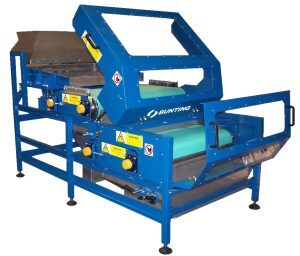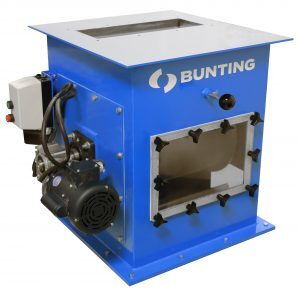An Introduction to Magnetic Properties of Ceramic Minerals: Part Four

In our previous blogs, we reviewed the problems that magnetic particle contamination can cause in ceramics production, discussed the different magnetic properties that minerals have, and took a deep dive into some of the consequences magnetic particle contamination can have in ceramics. In this blog, we will explain some of the different magnetic separation equipment used in ceramics processing and discuss how they combat the various problems caused by magnetic particle contamination.
Magnetic Separation of Minerals
In order to optimize magnetic separation efficiency, it is vital to have a thorough understanding of the magnetic properties of the minerals present in any given ceramic raw material. There are a wide range of magnetic separator designs available, and each utilize different strengths and types of magnetic field in order to achieve separation. In a single mineral processing operation, several designs of magnetic separator may be present.

High-intensity magnetic separators are available for both dry and wet processing. Many ceramic raw materials, such as silica sand, zircon, and feldspar, are handled and processed in a dry state. Because higher specification materials generate increased revenue, most ceramic mineral processors magnetically treat their own reserves. In this type of processing environment, high-intensity separators remove both free iron as well as magnetic minerals. Permanent designs, such as the Rare Earth Roll Magnetic Separator and Rare Earth Drum Magnet, as well as electromagnetic designs, such as the Induced Roll Magnetic Separator, are available. Electromagnetic options are typically preferable for handling high-temperature materials, such as materials being handled directly after drying.

It is common that free iron will be introduced into the raw ceramic material during the spray dry ceramic process. In this situation, both Rare Earth Roll Magnetic Separators and Drum Magnets are utilized in order to remove this problematic type of contamination.

After raw ceramic materials have been milled and mixed into glazes, slips, and body, another round of magnetic extraction will take place. At this stage in the process, the milling process has often liberated iron particles that were previously trapped, and more free iron has likely been introduced along the way as a result of screening, pumps, etc.
To serve as a final check and to ensure there is no visible contamination present in the glaze, neodymium rare earth tube magnets or magnetic liquid traps fitted with neodymium magnets are positioned either within the glazing station or in close range of it. Here, the magnetic separators will capture and remove any magnetic particles introduced to the glaze during transportation to the station.
Future Mineral Reserves
It is of great importance to understand mineralogy in terms of magnetic susceptibility when working in ceramics. It is particularly important during a time when traditional ceramic reserves are being depleted and more complex deposits are starting to be mined as alternatives. Because of the ongoing demand for white and pattern-free ceramics, there is no rest for ceramic producers and raw material suppliers in the battle to eradicate magnetic minerals and free iron from raw ceramic material.
Optimum Magnetic Separation Reduces Rejects
It is vital to have a full understanding of the ceramic manufacturing process when making recommendations for optimum magnetic separation equipment. Our experts at Bunting are happy to work with you one-on-one and answer all of your questions in order to equip you with the best magnetic separation equipment to serve the needs of your unique processing environment.
For more information about magnetic separators for the ceramics industry, contact Bunting today.



